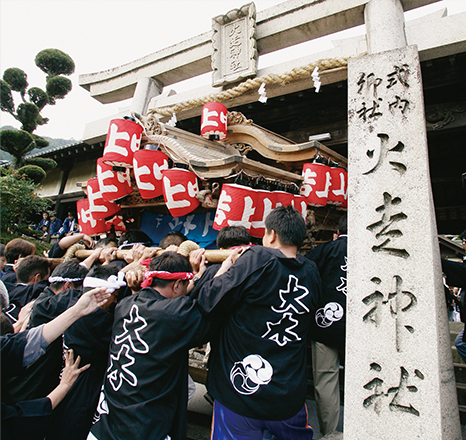Ninai danjiri event in the autumn festival of Hibashiri Jinja Shrine in Ogi
This traditional festival preserves the oldest style of the danjiri festivals in the Senshu area.
The event is rich in local flavor and inherits t the powerful atmosphere associated with lumber dealers, who represented a major occupational group in Ogi.

Hibashiri Jinja Shrine, which is the village shrine for the Ogi area, organizes an autumn festival each year. Three danjiri (floats) from the three district councils in the Ogi area, Kami-ogi, Naka-ogi and Shimo-ogi, are used exclusively for the festival, but these floats are not pulled by participants; instead, they are carried on the shoulders of the participants (ninai danjiri). This is currently the only ninai danjiri event organized in Izumisano City, although this style of danjiri used to be common in the mountainous area of Senshu. In a document from Kishiwada Domain dated 1752, there is a record of a ninai danjiri with a wooden box to house paper lanterns, bamboo blinds and other ornaments that was newly made in 1860. Hibashiri Jinja Shrine is listed in the Engi-Shiki, and Izumi Fudoki (records of the culture and geography of Izumi Province) mentions that the enshrined deity was Kagutsuchinokami.
The Masamoto-ko Tabihikitsuke records various performing arts and Shinto rituals organized in the shrine in great detail, including dengaku and sarugaku in August in the lunar calendar, ohitaki (festival to burn bonfires) by trained Buddhist priests of Inunakisan in November and elegant Buddhist incantations for the Bon Festival of the Dead at the height of summer. It is also recorded that in times of severe drought, priests from Shipporyuji Temple prayed for rain at Hibashiri Jinja Shrine and that if that failed, they offered prayers in the seven waterfalls and halls of Shipporyuji Temple and threw impurities such as the heads of deer into the waterfall basins as their final attempt, which eventually led to rainfall.
Originally, the ninai danjiri event was also called the “kenka matsuri” (fighting festival), in which the three danjiri carried by participants were smashed into each other. The danjiri are well designed to ensure that their carriers can climb up and down narrow roads, and they possess mechanisms that enable their roofs to be raised and lowered. These danjiri are therefore so rare that few similar floats are found in Osaka Prefecture. A paper lantern, on which is written the word “goshinto,” is carried on a pole at the head of the parade. While it is common for drums and other instruments to be put on danjiri and for people to ride on danjiri to play them, in the case of ninai danjiri, drums and gongs are hung on the inside. The instrument players go under the danjiri and play the instruments while walking along with it in a semi-crouching position. The floats are followed by a danjiri musical band comprised of children. This traditional event has inherited the atmosphere of a powerful festival and has a rich local flavor.






